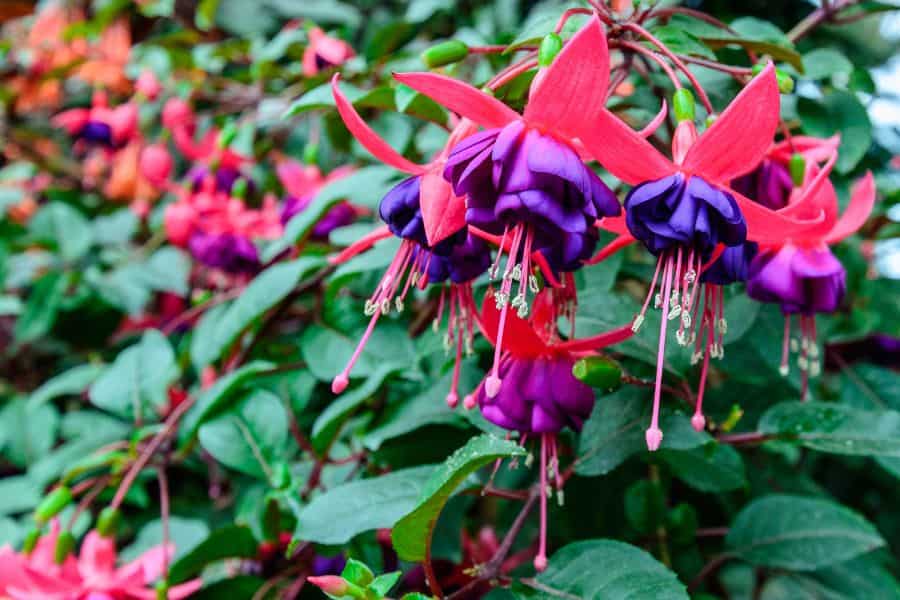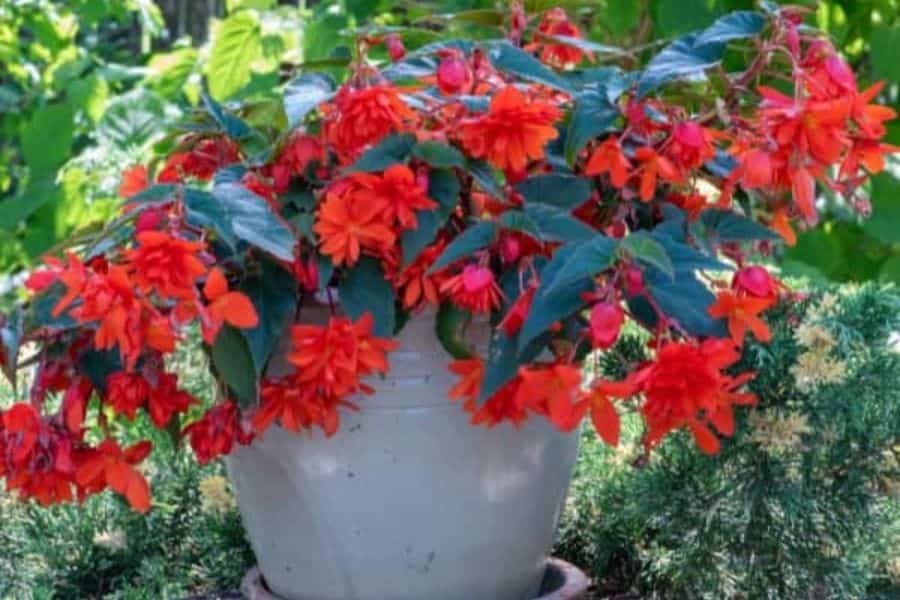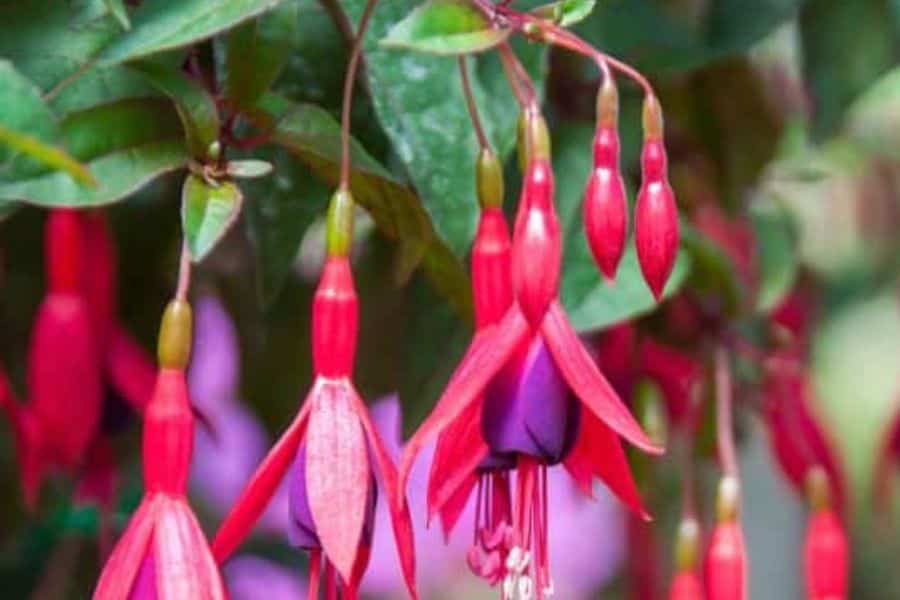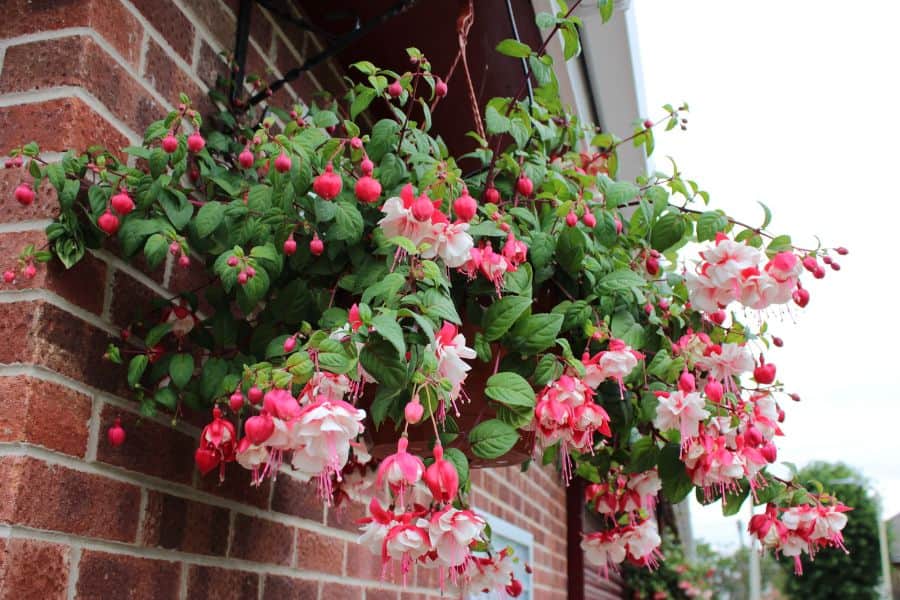Fuchsia is a genus of flowering plants that belongs to the family Onagraceae. These plants are native to Central and South America. Fuchsia is known for its striking pendulous, tubular flowers. These plants come in a variety of sizes and shapes; some species are small and shrubby, while others can grow into trees that are over 30 feet tall.

Our Selection of Fuchsia
There are a number of different fuchsia hybrids that are commonly found at Martin Garden Center. The most popular species of Fuchsia tend to be trailing varieties with large, double flowers that come in various colors, including pink, red, and purple. We offer them in 4″ containers or 10″ hanging baskets and used for its long blooming period.
Some of the varieties we carry at Martin Garden Center include Dark Eyes, Swingtime, Dollar Princess, Lena, and Marinka. Many of the latter are grown in 10″ Hanging Baskets. We do, at times, have various fuchsia varieties available in the Spring in 4″ containers. We also carry Gartenmeister Fuchsia in 4″ containers when it is available through our vendors. In 2025, we are growing the gorgeous variegated varieties, Autumnale and Firecracker, in 10″ hanging baskets. Wowsa … these will be something to see. They should be ready around April 1st.
How To Grow And Care For Fuchsia
Fuchsia plants thrive in well-drained soil, so over-watering is deadly. Splashing these plants when containers are beginning to dry is better than a full watering. They prefer partial shade or filtered sunlight, as direct sunlight can scorch their delicate leaves. Regular light watering is crucial for fuchsias, as they don’t like to dry out but they do not want to be overly saturated.
Fuchsia benefit from regular feeding to support their blooming and growth. Use a balanced, water-soluble fertilizer every two to four weeks during the growing season. Be cautious to avoid over-fertilizing, which can lead to excessive foliage growth with fewer flowers. Pruning is essential to fuchsia care to maintain a compact shape and encourage branching. Prune regularly to remove dead or damaged branches and shape the plant as desired.
It’s important to deadhead spent blooms regularly to promote continuous flowering. Pinch or cut off the faded flowers just above a leaf node to encourage new buds to form. This process diverts the plant’s energy into producing more blooms rather than setting seeds. Additionally, monitor for pests such as aphids and spider mites, and take appropriate action if infestations occur.

Leaves and Flowers
The leaves of fuchsia plants are typically oval or lance-shaped and are arranged in an opposite pattern along the stem. Their most distinctive feature is their flowers, which hang down from the stem and have a tubular shape with four petals and four sepals. The sepals are often brightly colored and resemble petals, giving the flowers a double-layered appearance. The flowers bloom profusely throughout the summer, attracting hummingbirds and other pollinators.

How to Use Fuchsia in Your Garden
- Hanging Baskets and Containers: Fuchsia’s trailing and cascading growth habit makes it an ideal choice for hanging baskets and containers. The long, tubular flowers dangle gracefully, creating a stunning display.
- Shade Gardens: Many Fuchsia varieties thrive in partial shade, making them excellent candidates for shaded or woodland gardens. Their tolerance for lower light conditions allows gardeners to introduce vibrant blooms in areas with limited direct sunlight.
- Mixed Borders and Edging: Fuchsias with upright growth habits can be used as striking elements in mixed borders or as edging plants. Their colorful flowers and lush foliage contrast well with other garden plants.
- Attracting Hummingbirds: The tubular flowers of Fuchsia are particularly attractive to hummingbirds. Planting Fuchsia in garden beds or hanging baskets can serve as a natural way to attract these delightful pollinators.

Frequently Asked Questions
Do Hummingbirds Like Fuchsia?
Yes, Hummingbirds are known to be attracted to Fuchsia flowers. Fuchsia plants produce tubular, drooping flowers that are particularly well-suited for hummingbirds. Fuchsia flowers provide an excellent food source, and these agile birds often hover around Fuchsia plants, feeding on the nectar.
Are Fuchsia Plants Deer Resistant?
Fuchsia plants are not considered highly deer-resistant, as their tender foliage and flowers can attract browsing deer, especially when food is scarce. While some gardeners report that deer tend to avoid them in favor of more palatable plants, Fuchsia is not a reliable choice for deer-prone areas. If you want to grow Fuchsia in a garden where deer are a concern, consider planting it near more deer-resistant plants like lavender, salvia, or ornamental grasses. Using deterrents or planting Fuchsia in hanging baskets and containers out of reach may also help protect them from browsing.
